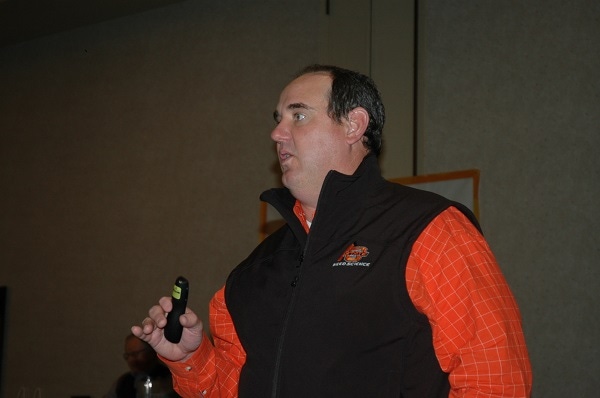
Farmers can either take steps to prevent herbicide resistant weeds from becoming a problem or they can wait until resistance develops and then try to figure out how to claw their way out of a mess.
Todd Baughman, Oklahoma State University agronomist at the Institute for Ag Biosciences in Ardmore, prefers door number one and says producers need to take an integrated approach to weed management to prevent resistance.
Baughman, speaking at the recent Oklahoma Peanut Expo in Lone Wolf, Okla., said the cheapest and most effective way to manage herbicide resistant weeds is to prevent the problem. And that’s not as hard as it might seem, considering some of the horror stories coming from areas where resistance has created significant management problems.
For more information on weed control and other practices, please check out Southwest Farm Press Daily and receive the latest news right to your inbox.
“Start clean,” Baughman recommends. A yellow (pre-emergent) herbicide is a good start. “About 98 percent of Oklahoma’s peanut acreage is irrigated,” he said. That means farmers have the option of applying ample water to activate those yellow herbicides. “I would not plant a peanut without using a yellow herbicide. We can incorporate the material with water and the key is to apply enough water. I prefer to put (pre-emergence) herbicides out through the system.”
He recommends from three-fourths to one inch of water to activate the herbicide. “And make certain every nozzle delivers that much water.”
Consider resistance in weed management strategies
Proper weed identification is another critical element in resistance management, he said. “Know how each herbicide works on a particular weed. Weed size is also a factor. It’s easier to kill the small ones. But they grow quickly, so determine how many acres you can spray in a day.”
He said farmers should buy good quality seed and strive for a healthy crop. “Also, rogue out the field if you see escapes. And manage weeds in turn rows, fence lines, corners and ditches.”
He advises combining the worst fields last to keep from spreading weed seed into clean fields. “Don’t plant something you can’t control later.”
Crop rotation can break weed cycles with different growing conditions and a different set of herbicides. “If grazing, graze the worst fields and then control weeds after pulling the cattle off.”
He said rotating chemistry is also important. The herbicide’s mode of action and site of action are important considerations in switching up products. “I am concerned about the pressure we may be putting on Valor herbicide,” Baughman said. “We often follow Valor with Cadre or Blazer and they all work on the same plant enzyme. We could see resistance to Valor.” He recommends adding another mode of action, something like Pursuit to the mix.
Rotate chemistry
“Do not rely on a single method for weed control. We may need to consider cultivation again.”
Many farmers have gotten away from tillage with reduced till systems, but Baughman said plowing does a good job on a weed like horseweed/marestail. “Also, use a product with an alternate site of action.”
Palmer amaranth (pigweed) poses problems as well. “Pigweed has both male and female plants so a lot of crossing in the environment is possible.” That increases the chances of transferring resistance, especially since pigweed produces a large number of seed (as many as 500,000 per plant).
Baughman said resistance doesn’t just develop in a field. Resistant weeds are already there; farmers simply select for them by using the same herbicide over and over and killing off the susceptible weeds and leaving the resistant ones with little competition.
“Depending on one herbicide is a big factor. A single site of action can select for resistant weeds.”
Weeds that survive can explode in a short time, growing from one pigweed plant per 100 feet of row to as many as one every three square feet in about two years. Controlling 99 percent of the weed population still leaves enough to continue building damaging infestations if the same herbicide is used alone. But adding a second herbicide, one with a different mode of action, can soon take the population back to where it started.
“We have to be prepared to control pigweed,” Baughman said.
The prospect should not be overly daunting. “We were controlling weeds before we had resistance,” Baughman said. “We can still control weeds if we don’t make the solution worse than the problem. Not every control issue is a resistance issue. Some weeds are just hard to kill. The climate also plays a role, as was the case the past two years.
“But we have seen a dramatic increase in weed resistance over the past 25 to 30 years. That increase is a result, he said, of too much reliance on a specific herbicide with a single mode of action. He noted products such as Glean, Ally and Cadre as herbicides that “work on a single enzyme. A slight modification of the plant population could affect control.”
He said farmers are using more herbicides than they did in the 1970s but are using much lower rates. “We have reduced the number of pounds of herbicides in the environment.”
Allowing a serious infestation of resistant weeds to develop could make weed control much more challenging, Baughman said. “We have to go to an integrated weed management program that includes reduced reliance on one mode of action, use of a number of different control techniques, multi-year management systems, timely applications and use of residual herbicides.”
Prevention, he said, is the most sensible approach to resistant weed management.
Also of interest:
Go back to yellows for resistant weed control in cotton
Consider resistance in weed management strategies
Across the Sunbelt, herbicide resistance changes production options
About the Author(s)
You May Also Like






